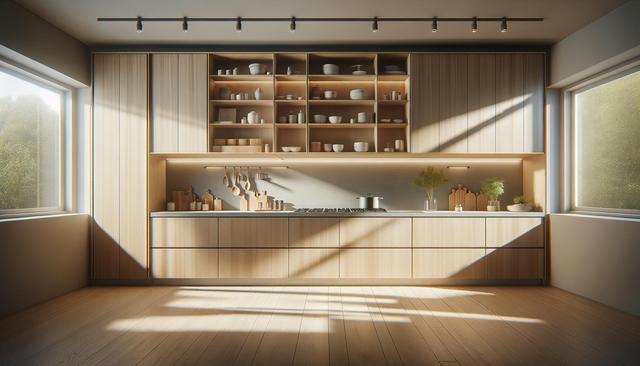Understanding the Role of Kitchen Cabinets
Kitchen cabinets serve as the backbone of your kitchen layout, organizing everything from cookware to pantry items. Beyond their practical use, they contribute significantly to the aesthetic appeal of your kitchen. The style, color, and material of the cabinets set the tone for the entire space, making them a crucial design element. Whether you’re remodeling or building a kitchen from scratch, understanding the impact of cabinetry is the first step to a successful project.
Cabinets are available in a variety of configurations, including base cabinets, wall-mounted units, and tall pantry cabinets. Each type serves a specific function and can be customized to accommodate your kitchen’s layout and storage needs. Knowing the role each type plays helps ensure your kitchen remains organized and efficient in daily use.
Materials and Finishes: What to Consider
Choosing the right materials and finishes for your cabinets is essential for both durability and design appeal. The most commonly used materials include:
- Solid wood – known for its strength and natural beauty
- Plywood – offers good durability and resistance to moisture
- MDF (medium-density fiberboard) – provides a smooth finish for painted cabinets
- Particleboard – a more affordable option, suitable for lower-traffic areas
The finish you select also affects the longevity and look of your cabinets. You can choose from stained, painted, laminated, or thermofoil finishes, each offering unique benefits. Painted cabinets allow for a wide range of color choices, while stained finishes highlight the natural grain of the wood. The selection of materials and finishes should align with your cooking habits, climate conditions, and overall kitchen style.
Popular Kitchen Cabinet Styles
Cabinet style plays a major role in defining the overall theme of your kitchen. Some well-regarded styles include:
- Shaker – simple and timeless with clean lines
- Flat-panel – sleek and modern, perfect for minimalist designs
- Inset – features doors set within the frame for a classic look
- Beadboard – adds texture and a cottage-style warmth
Each style has its own visual impact and functional benefits. For instance, shaker cabinets are versatile and suit a range of interiors, while flat-panel cabinets offer easy maintenance and a seamless appearance. When selecting a style, consider the long-term visual appeal and how it complements other elements in your kitchen like countertops, appliances, and flooring.
Cabinet Organization and Storage Solutions
Modern kitchen cabinets offer more than just shelves and drawers. With smart storage solutions, you can maximize space and improve accessibility. Here are a few popular cabinet organization features:
- Pull-out trays for pots and pans
- Lazy Susans for corner cabinets
- Built-in spice racks and utensil organizers
- Vertical dividers for baking sheets and trays
These features not only streamline your cooking process but also help maintain a clutter-free environment. Custom inserts and adjustable shelving can be tailored to your specific needs, making your kitchen work harder for you. Investing in functional storage elements enhances both usability and satisfaction with your kitchen space.
Planning Your Kitchen Cabinet Layout
Before purchasing or installing cabinets, it’s important to plan your kitchen’s layout carefully. The layout should support efficient workflows, such as the classic kitchen work triangle: the optimal placement of the sink, stove, and refrigerator. Your cabinet plan should support this flow and ensure that frequently used items are easily accessible.
Consider the following when designing your layout:
- Height and depth of cabinets to suit your needs
- Integration with appliances and lighting
- Space for countertop work areas
- Aesthetic balance and symmetry
Using design software or working with a kitchen designer can help you visualize different layout options. The goal is to create a space that is both visually pleasing and functionally sound. A well-planned layout will enhance your cooking experience and add long-term value to your home.
Conclusion: Making Smart Choices for Your Kitchen
Selecting kitchen cabinets involves more than picking a color or style. It’s about choosing materials and layouts that fit your lifestyle and enhance your home’s value. Whether you’re upgrading existing cabinets or planning a full remodel, careful consideration of design, functionality, and organization can result in a kitchen that serves your needs for years to come. Taking the time to make informed decisions ensures your kitchen is not only beautiful but also a practical and enjoyable space for daily life.


